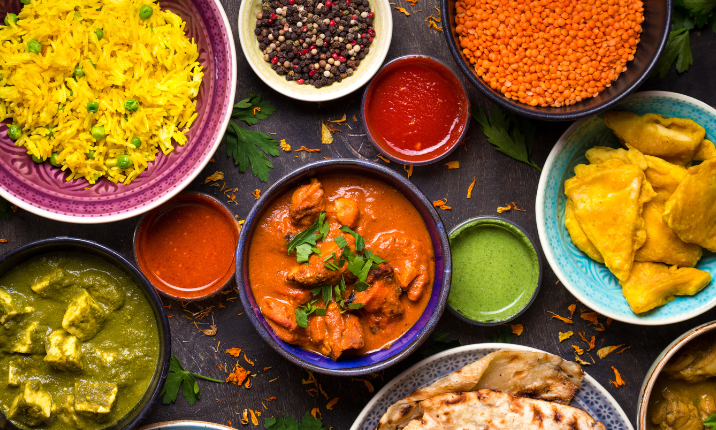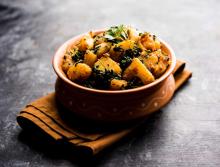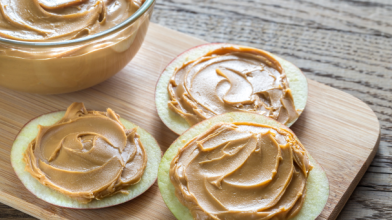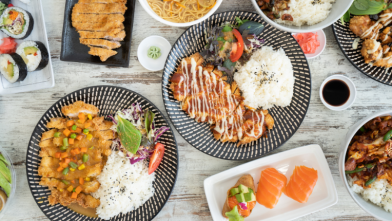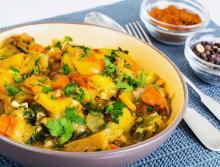
Rice
Several staple ingredients are commonly used in Indian cooking, each with its own unique properties. Basmati rice is used often for its fragrant aroma and fluffy texture. Opting for brown basmati rice over the refined white variety offers a healthier alternative.
On average, a one-cup serving of cooked brown rice contains about 3.5 grams of fiber, while the same serving of cooked white rice contains approximately 0.6 grams of fiber. The higher fiber content in brown rice contributes to its slower digestion and absorption, resulting in a slower and steadier rise in blood glucose (blood sugar) levels compared to white rice. As a result, brown rice is a healthier option for those managing conditions like diabetes or looking to improve their overall fiber intake. Consider swapping the rice for riced cauliflower if you are looking for a lower carbohydrate option.
Spices
Spices like turmeric, cumin, and coriander are central to Indian cuisine, adding richness and aromatic depth to dishes. Turmeric, renowned for its anti-inflammatory properties, infuses curries and stews with vibrant color and earthy notes. Similarly, cumin and coriander contribute warm, nutty flavors. Alongside enhancing flavor, these spices provide antioxidants, which are essential for maintaining an anti-inflammatory diet.
Oil
Ghee, a traditional Indian cooking fat, adds richness and a buttery flavor to dishes but is high in saturated fat. Opting for heart-healthy oils such as olive or avocado oil are healthier alternatives for using in Indian cooking.
Legumes and Protein
Legumes, including lentils and chickpeas, are cornerstones of Indian cuisine, offering protein and fiber that help you feel full and maintain healthy blood glucose level. An excellent source of plant-based protein, legumes are an important part of vegetarian and vegan diets as well those looking to diversify their protein sources.
Legumes include lentils, chickpeas, black beans, kidney beans, and peas. On average, they contain about eight grams of protein per half-cup serving, making them a good source of plant-based protein. In addition to protein, legumes are rich in fiber, which is beneficial for digestive health, weight management, and blood glucose regulation.
Veggies
Vegetables such as spinach, cauliflower, and eggplant play a vital role in Indian cooking, providing essential vitamins, minerals, and fiber. These versatile ingredients not only add texture and color to dishes, but also contribute to nutritional value. Increasing your non-starchy vegetable intake promotes satiety and supports blood glucose management.
Diabetes-Friendly Indian Meal Ideas
Here are a few traditional Indian meals that can be incorporated into a diabetes-friendly meal plan:
- Chana masala with quinoa: Substitute traditional white rice with quinoa, a protein-rich grain that has a lower glycemic index. Start by sautéing onion in a small amount of oil until translucent. Add garlic, ginger, and a mix of ground coriander, cumin, turmeric, and chili powder, cooking until fragrant. Stir in diced tomatoes and simmer before adding drained chickpeas. Season with salt and simmer until heated through. Garnish with cilantro before serving with quinoa.
- Vegetable biryani with brown basmati rice: Prepare vegetable biryani using brown basmati rice instead of white rice for a healthier alternative with added fiber. Sauté onions, carrots, and peas in a small amount of oil until tender. Add garlic, ginger, and a blend of biryani spices such as cumin, coriander, turmeric, and garam masala, cooking until fragrant. Stir in basmati rice and low-sodium vegetable broth, then add diced potatoes and cauliflower florets. Cover and simmer until the rice is cooked and vegetables are tender. Garnish with chopped cilantro and fried onions before serving with brown rice.
- Tandoori chicken with grilled vegetables: Marinate chicken in a blend of low-fat yogurt and tandoori spice mix (you can usually find this mix in the spice section at the grocery store), then grill until tender and juicy. Serve with a side of grilled vegetables such as bell peppers, zucchini, and onions for a low-carb, protein-packed meal.
- Palak paneer with whole wheat roti: Enjoy creamy palak paneer, a puréed spinach and paneer cheese curry, with whole wheat roti instead of white naan bread. Whole wheat roti is higher in fiber, making it a healthier choice for individuals managing diabetes. Roti is a type of unleavened flatbread that is a staple in Indian cuisine and many other South Asian countries. It is typically made from whole wheat flour, water, and salt.
- Dal tadka with cauliflower rice: Serve dal tadka, a comforting lentil stew, with riced cauliflower as a low-carb alternative to white rice. Cauliflower “rice” provides a lighter option that is lower carb, making it suitable for diabetes-friendly meals. For a quick dal tadka, heat oil and add cumin seeds, mustard seeds, and onions, sautéing until onions are golden brown. Stir in garlic, ginger, and chopped tomatoes, cooking until tomatoes soften. Add cooked lentils to the mixture along with turmeric, chili powder, and salt. Finish with a squeeze of lemon juice and garnish with fresh cilantro before serving with cauliflower rice.
The Takeaway
By trying out these healthier tweaks and choosing ingredients packed with nutrients, you're exploring new flavors and looking after your health, especially if you're managing diabetes. It's about enjoying the rich culinary heritage of traditional Indian cuisine while making choices that support your wellbeing. So, give it a shot, experiment with different ingredients, and enjoy every bite knowing you're making delicious and nutritious choices for yourself.
Try these other diabetes-friendly Indian recipes:
- Image

If you want to add more non-starchy vegetables to your diet, try this recipe that utilizes a variety of veggies to pack in the flavor.
- Image
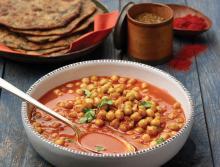
Chana, or chickpeas, masala is an extremely popular dish in both India and the U.S. This diabetes-friendly version uses a mixture of spices for a flavorful dish.
- Image

Lassi is a yogurt-based smoothie that uses fresh fruit and herbs to make a delicious treat. Try this naturally sweetened version!
This recipe for a spiced Indian spinach dish replaces the regular potatoes with sweet potatoes for a delicious and healthful new take on curry.
